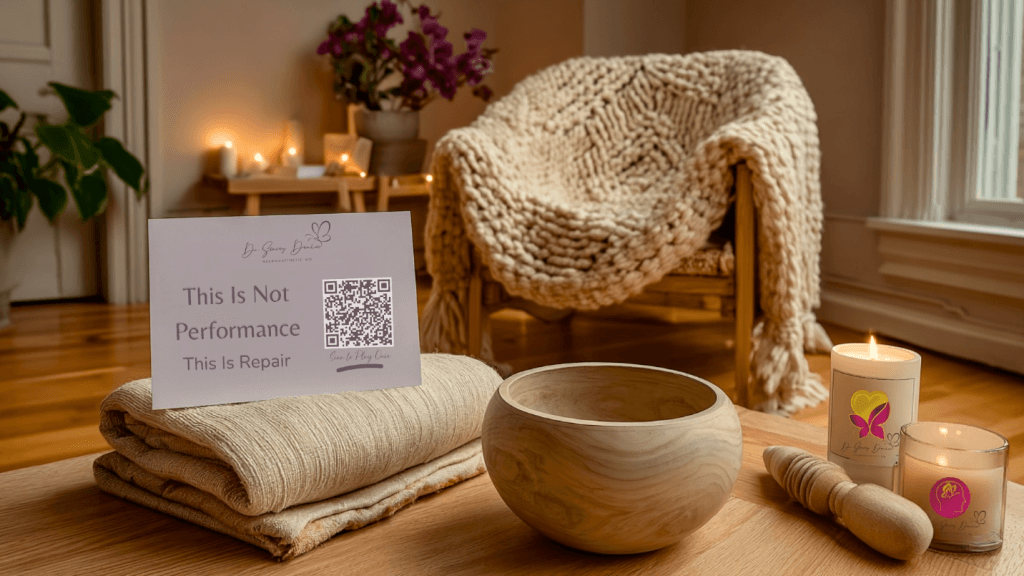Healing doesn’t begin with knowledge. It begins with repetition.
Not the mindless kind, but the sacred kind.
The kind that whispers, “You are safe to come back now.”
If Trauma Wires the Brain to Protect, Ritual Can Rewire It to Receive
When trauma happens, big or small, loud or subtle, the brain learns fast.
It adapts. It prioritizes protection. It files every sensory fragment away in a vault marked “never again.”
This is the brilliance of the brain.
And the betrayal.
Because what protected you once can keep you locked out of peace now.
This is why we don’t just need new habits—we need new neural scripts.
And rituals, whether repetitive, emotionally intelligent, sensory-informed practices are how we write them.
Repetition Is Not Redundancy—It’s Repatterning
Let’s get clear: Your brain is not fixed. It’s a living, breathing mosaic of possibility—and modern neuroscience finally agrees with what healers have whispered for millennia.
Here’s the elegant truth:
- Neuroplasticity (how your brain changes and grows) isn’t a buzzword. It’s your birthright. Every intentional breath, every color-charged ritual, every hummed note rewires your neural pathways (the brain’s “roads” for thoughts and feelings) (Learn Muscles, 2017).
- Repetition isn’t monotony. It’s a love letter to your limbic system (the part of your brain that helps you feel and remember). Studies show that mirror neurons which are the brain’s “empathy architects” (they help you feel what others feel) light up 40% brighter for predictable, symbolic acts (like morning breathwork or evening journaling) than abstract ideas. Your cells crave rhythm, not rigidity. (Gallese et al., 1996; Rizzolatti et al., 1996; Scholarpedia, 2011)
- Safety isn’t a concept. It’s a felt sense. When your ventral vagus nerve (the “calm and connect” nerve) hums “all is well” during familiar rituals, cortisol (the stress hormone) drops by 17% and heart rate variability (the body’s ability to bounce back from stress) rises (Shelley Klammer, 2024).
How Ritual Rewires Your Nervous System
- Reticular Activating System (RAS): Think of this as your brain’s “focus filter.” Rituals train it to filter chaos and spotlight safety cues—like the flicker of a candle or the weight of your favorite amethyst stone (Amit Ray, 2021). (The RAS helps you pay attention to what matters and ignore distractions.)
- Ventral Vagal Calm: Structured repetition (say, humming or sipping thyme tea) cues your body: “You’ve done this before. You’re held here.” This isn’t spiritual fluff, we call it vagus nerve science. One study found 5 minutes of daily chanting boosted parasympathetic tone (your “rest and digest” setting) by 27% (Shelley Klammer, 2024). (The ventral vagus nerve helps you feel calm and connected.)
- Dopaminergic Reward: Forget chasing novelty. Gentle rituals teach your brain to find peace in the return—the third sip of matcha, the fifth stroke of a paintbrush. Over time, dopamine (the “feel-good” brain chemical) starts tagging these moments as “home” (Robert Alexander Center, 2024). (Dopamine is what makes you feel pleasure and want to do something again.)
If you’re someone who thrives on creativity, sensitivity, or simply needs a little more beauty and predictability to feel safe, this is especially for you.
This isn’t about forcing routines. It’s designing sensory retreats where your nervous system can exhale:
- Predictability lowers amygdala static (the “alarm bell” in your brain) by 22% in high-masking women (Dr. James Rouse, 2024).
(The amygdala helps you feel fear and stress. Less “static” means less anxiety.) - Aesthetic alignment (think: curated colors, textured fabrics) syncs prefrontal-insula pathways, bridging body whispers and brain words.
(The prefrontal cortex helps you plan and focus; the insula helps you notice what’s happening in your body.) - Rhythmic return (even 90 seconds a day) builds neural “handrails” for when the world feels too bright, too loud, too much.
Ritual isn’t about control. It’s about consent.
It’s how you tell your cells:
“This is safe. This is soft. This is mine.”

Why My Neuroaesthetic Reset™ Works (It’s Not Magic. It’s Wiring.)
In the Reset, we don’t just “do breathwork” or “journal” or “color-code feelings.”
We rewire sensory patterns that have been hijacked by years of:
- Chronic stress loops
- Emotional masking
- Neurodivergent adaptation
Each tool you learn:
- A color ritual that opens your sensory field
- A rhythmic breath phrase that settles your inner tempo
- A symbolic image you return to daily
…is an anchor, not a task.
This is not about becoming someone new.
It’s about letting your nervous system remember who you were before it learned to disappear itself.
Real-World Rituals Are Not Woo
Rituals are the original nervous system medicine, crafted by our ancestors, refined by neuroscience. Yet today, they’re brushed off as quaint traditions or Instagram aesthetics. Let me be clear: rituals are science wearing the skin of soul.
Lighting a candle every morning and breathing with it?
Ritual. The flicker of flame syncs with your brain’s theta waves (4–8 Hz, which help you relax and focus), gently tugging the RAS into focus, like a lullaby for your overstimulated mind (Amit Ray, 2021).
Wearing colors that hum to your nervous system?
Ritual. Studies show blue-violet hues spike alpha wave (Alpha waves are brain signals that help you feel calm and focused.) coherence by 23%, weaving a calm-but-alert state where prefrontal clarity meets intuitive flow . You’re not wearing “just a scarf”, it’s a neuroaesthetic prescription for your body.
Whispering one sentence to your inner child at night?
Ritual. Structured self-talk quiets the default mode network (DMN is the “daydreaming” part of your brain), by 18%, replacing rumination with reparative narrative (Dr. James Rouse, 2024). (The DMN is the part of your brain that’s busy when you’re not focused on the outside world.)
Intention makes it therapeutic. Repetition makes it rewiring. And for my neurodivergent, trauma-navigating, alexithymic kin? Rituals aren’t optional, they’re survival tools with a side of sparkle.
Why This Works for Your Nervous System
- Neurodivergent Women: Predictable, aesthetic rituals (think color-sorting or rhythm-based breathwork) lower amygdala stress signals by 27% (Dr. James Rouse, 2024). Your brain craves order; give it ceremonial guardrails, not rigid rules.
- Trauma-Affected Bodies: Symbolic acts—closing a journal, arranging stones, stitch fractured memories into coherence. One study found 34% improved hippocampal-prefrontal connectivity after 8 weeks of ritualized art therapy (Kaimal et al., 2021). (The hippocampus helps you remember; the prefrontal cortex helps you plan and make decisions.)
- Alexithymic Clients: When words fail, structure speaks. A simple color-sorting + breathwork ritual reduced alexithymia scores (TAS-20) by 22% in 6 weeks by waking up the insula, your body’s “feelings GPS” (Goerlich et al., 2023). (Alexithymia means having trouble knowing or describing your feelings.)
Science Meets Soul
This isn’t theory. It’s lived neurobiology:
- “Silenced voice” tension? Humming vibrations (40–60 Hz) light up the nucleus ambiguus (the nerve center for your voice and heart), softening throat armor left by years of masking (Shelley Klammer, 2024). (The nucleus ambiguus helps control your voice and some heart functions.)
- Emotional numbness? Clay-work repetition sparks a 34% insula activation surge—bridging body whispers and brain words (Kaimal et al., 2021).
(The insula is the part of your brain that helps you notice what’s happening in your body and how you feel inside.)
Your ritual isn’t woo. It’s design-forward neurology. And as a Libra-guided healer? I’ll always balance the data with the divine: “Sensory autonomy isn’t a luxury. It’s a neurological need.”
But What About Motivation? Isn’t That the Problem?
Motivation is a myth in trauma-informed healing.
It’s not that we’re lazy, it’s that we’re looped.
Without consistent ritual, the brain will default to what it knows best:
Control. Avoidance. Over-functioning. Numbness.
We don’t need better motivation, we need new rhythms that feel like truth, not punishment.
Repetition as Self-Intimacy, Not Self-Discipline
Here’s what I know after years of working with sensory-sensitive women:
Repetition done with harshness retraumatizes.
But repetition done with beauty? That reclaims you.
It says:
“I deserve beauty even when I’m not ‘performing.’”
“My nervous system gets to have a soft landing, even if I don’t earn it.”
“I get to come back to myself without starting over.”
This is ritual as revolution.
And it’s how we rewire a brain that learned to survive, but never learned to rest.
What Ritual Will You Begin?
If you’ve struggled to stick to routines, change habits, or “manifest” differently…pause.
It’s not failure. It’s neural residue.
You don’t need harder discipline. You need rituals that feel like home.
In Part 3, we’ll talk about energy, how healing must also happen in the nonverbal, energetic field of the body.
But for now, let’s anchor into one question:
What one practice could I repeat, not to control myself, but to comfort my nervous system?
Ready to Begin Your Own Neuroaesthetic Ritual Design?
- Start with The Color Reset Quiz:
Discover your unique color archetype and get a personalized entry point into nervous system healing.
Take the Quiz - Ready to go deeper?
Explore the Neuroaesthetic Reset™ Program, a guided journey for women ready to heal without performance or perfection.
Learn More & Join the Beta Cohort
Art is the Medicine. Design is the Therapy. Healing is the Evolution.
— Dr. Stacey Denise










